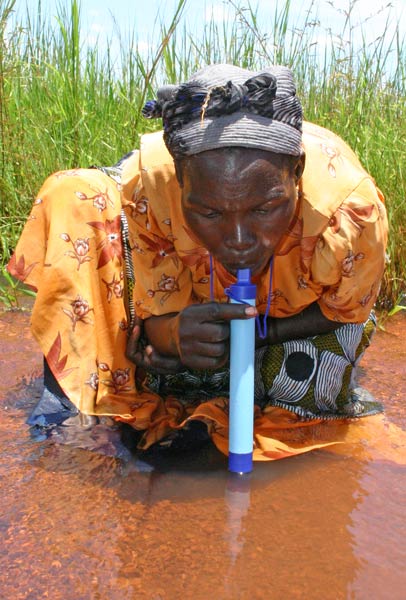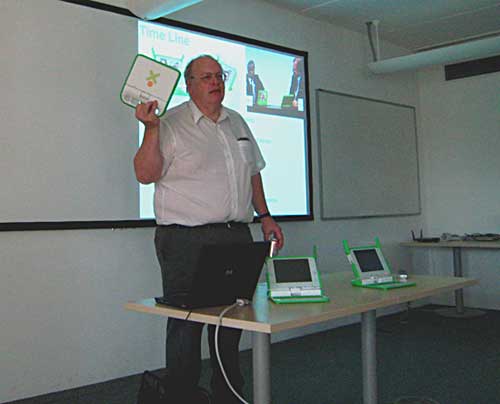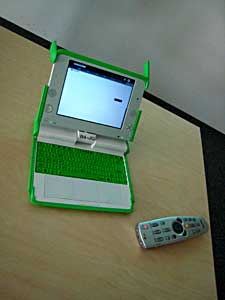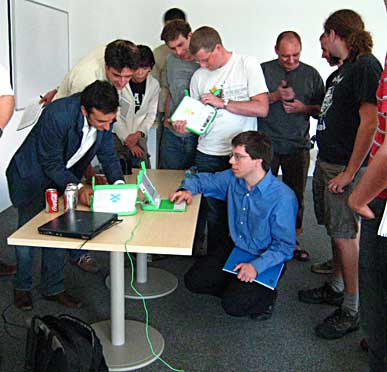Useful Tech Review interview. Includes a link to this video of nine-year-old kids replacing the motherboard on the XO laptop.
Category Archives: Digital Divide
We’re the World Food Program and they’re McDonalds
That was Nicholas Negroponte’s way of describing the difference between the OLPC project and its erstwhile ‘partner’, Intel. The quote comes from a revealing interview in Fortune. Excerpt:
When Intel joined us we thought we could move toward that being a reference design more and more, and less toward them selling the Classmate itself.
But oddly it went in the other direction. And then they started using their position on the board of OLPC as a sort of credibility statement. When they disparaged the XO to other countries they said that they should know about it because they were on the board. They even had somebody go to Peru, which was a done deal for OLPC, and rant and rave to the vice minister in charge. He dutifully took copious notes and was stunned.
Fortune: And he shared them with you?
Yeah. It was unbelievable. “The XO doesn’t work, and you have no idea the mistake you’ve made. You’ll get yourselves into big trouble,” and that kind of stuff. We kept the sale of course, but when one of your partners goes and does that, what do you do? It first happened in Mongolia. And at that point [Intel CEO] Paul Otellini called me and basically asked to not be thrown off the board, because they were going to change their ways. But they didn’t.
Fortune: Why, do you think?
He’s got 100,000 people and he can’t control all of them. That’s part of his problem. When I sign a nondisparagement clause that means all our people. He said we’ll get a machine ready for CES and make a joint statement together there. As recently as three days ago we still thought we were going to introduce it. We had asked them to do very very small things and they just decided not to.
Fortune: Do you wish OLPC and Intel could be less acrimonious?
Well, we weren’t acrimonious for 7 months. But they signed an agreement and didn’t do one single thing in the agreement.
Fortune: Like what?
Nondisparagement is the easiest. That clause they violated all over the place. They said they’d work on software, but they didn’t touch it. We said we’d work on the architecture together, and that wasn’t done. We said we’d work on a processor and to this day don’t have a spec on it. The nonfulfillment on theiir side was so continuous I don’t even know what to say.
Fortune: So the real issue was they were competing with you?
We’re like the World Food Program and they’re McDonald’s. They can’t compete. They are both food organizations but for completely different purposes. If the Classmate were in the hands of every single child in the world, that would be pretty good. Could it have better power characteristics, a better display, etc.? Sure, that would be good. But I don’t care if kids get the XO so much as that they get laptops.
Fortune: So what happens now?
Nothing different. We’re sort of unemcumbered, so we can move forward with clarity, to be honest with you.
Leopards like Microsoft and Intel never change their spots. They can’t.
Intel parts company with OLPC
Now there’s a surprise! John Markoff of the NYT reports that:
Intel said Thursday that it had chosen to withdraw from the One Laptop Per Child educational computer organization, which it joined in July after years of public squabbling between Intel’s chairman, Craig R. Barrett, and the group’s founder, Nicholas P. Negroponte.
The low-cost laptop, originally priced at $100, has captured the public imagination but also created intense controversy because it was viewed as a potential competitor for both Intel and Microsoft in the developing world.
The machine, which is based on the freely available Linux operating system and comes with educational software, is now built with a microprocessor made by Intel’s archrival, Advanced Micro Devices. The PC, called the XO, is being sold for about $200 apiece to governments and institutions.
On Thursday an Intel spokesman said the company shared with O.L.P.C. the vision of putting computers into the hands of children, but the two were not able to work out what he described as “philosophical” differences.
Intel did not attend a recent board meeting of the group in Florida, according to a person familiar with the events, who asked not to be named because he had not been given authority to describe the events. That set off a bitter private dispute, which led to the Thursday announcement.
“We’ve reached a philosophical impasse,” said Chuck Mulloy, the Intel spokesman. “Negroponte had asked us to exclusively support O.L.P.C.-based platforms.”
Uruguay buys first ‘$100 laptops’
Hooray! BBC NEWS report…
The first official order for the so-called “$100 laptop” has been placed by the government of Uruguay.
The South American country has bought 100,000 of the machines for schoolchildren aged six to 12.
A further 300,000 may be purchased to provide a machine for every child in the country by 2009.
The order will be a boost for the One Laptop per Child (OLPC) organisation behind the project which has admitted difficulties getting concrete orders.
“I have to some degree underestimated the difference between shaking the hand of a head of state and having a cheque written,” Nicholas Negroponte, the founder of the organisation, recently told the New York Times.
The Lifestraw

Picture credit: Vestergaard Frandsen
From Photos: Low-cost tech that meets basic needs | CNET News.com…
People can safely drink from polluted bodies of water through the go-anywhere LifeStraw, which filters more than 99 percent of life-threatening bacteria and viruses. It costs up to $5 and lasts about a year, filtering 2 liters per day. A quarter of a million LifeStraws are in use throughout Asia and Africa, where nonprofit groups distribute them following emergencies, such as this month’s monsoon floods in India.
LifeStraw maker Vestergaard Frandsen is working to develop water filters to shut out toxic chemicals, such as arsenic found commonly in Bangladesh. Its new household filter can handle 15 times the amount of water as the straw. The Swiss company spent millions of dollars over a decade to develop the LifeStraw, which grew out of the nonprofit Carter Center’s goal to eradicate the Guinea worm disease. The prevalence of this ailment, caused by a water-borne parasite prevalent in western Africa, has shrunk to less than 100,000 cases from 50 million in the 1950s.
Neat, eh?
Who’s this?

[Clue]
Dream Realisation, release 1.0

When we embarked on the Ndiyo Project we always knew that the realisation of the vision depended on shrinking the thin client down to a chip. Well, our colleagues at DisplayLink have done it! This is the USB version of the Nivo, and it’s now in the back of monitors from two of the world’s leading manufacturers of displays — Samsung and LG. It’s an amazing achievement. And there’s more to come. Stay tuned.
The $100 laptop, Plan B
The WSJ is reporting a change of tack by Nick Negroponte and his One Laptop Per Child project. (IHT report here.)
The high-profile “One Laptop Per Child” effort to bridge the digital divide between the developed and developing worlds is setting its sights closer to home.
After months of debate, the program is set to announce today that it will sell its affordable “XO” laptops, custom-built for the developing world, in North America. But there is a twist: Buyers here must purchase two computers — one for themselves and one for a child in the developing world, for a combined cost of $399, some of which is tax-deductible.
The nonprofit program also is talking to more than a dozen governors and numerous school districts about bulk orders, according to Walter Bender, president for software and content for the One Laptop per Child Foundation, of Cambridge, Mass. Offering the computers in the U.S., he says, will help finance overseas deployments and raise awareness about the project among U.S. students and teachers…
This is great news for several reasons. It shows courage and flexibility on the part of Nicholas Negroponte and his team. It’s been clear for some time that their original strategy — of getting governments in developing countries to sign up for bulk orders of a million+ was never going to work when it came to the crunch. Most of these governments couldn’t run a bath, never mind execute a coherent, bold ICT strategy. So there was an urgent need for a Plan B.
Now we know what it is. My hunch is that the ‘buy two, donate one’ might just take off in a big way. First of all, it enables many people in the developed world to get their hands on what is a very neat device. Secondly, it ties neatly into the philanthropic instincts of many technophiles. I’d happily buy some machines on the basis proposed — not least because I’m convinced that there are useful things Ndiyo can do with the laptops. The only snag is that the purchase offer is only open to US and Canadian residents. (Thinks… time to lean on some of my American friends.)
Aside: I love people who are big enough to change their minds in public. I’ve never shared the British media’s hysterical contempt for “U-Turns”. Often a U-turn is the only rational thing to do. Consistency — as Oscar Wilde said — is a puerile obsession. And, as Keynes famously retorted to a journalist who accused him of an about-face: “When the facts change, I change my mind. What do you do?”
The $100 laptop — update

Jim Gettys, VP of Software for the One Laptop Per Child project was in Cambridge today and gave an impromptu seminar at the Computer Lab. It was a fascinating insight into the amount of hard work and ingenuity that has gone into the design of this elegant little gizmo:

Jim had three of the laptops in his bag and left them out for us to examine.
I took notes as he talked and may blog a full account later. But, looking back, the headlines are:
Wireless networking is central to the project, and it does mesh networking in a really neat way. My Airport card picked up the mesh immediately, and it was interesting to see the neat way the OLPC interface represents other wireless nets. They’ve done a lot of hard thinking about power consumption and have come up with some very neat tricks for paring down consumption. The CPU is off much of the time, for example. The display (a custom-built 7.5″ 200 dpi TFT ultra-low power consumption screen) is readable in bright sunlight. Jim had a nice slide of the laptop alongside a traditional HP laptop in blazing sunshine. Guess which screen is an unreadable black? The laptop has a built-in camera — rather like the iSight built in to Intel Macs. Kids love this, apparently. There are plans to sell OEM versions of the laptop in developed countries — but for considerably more than $100. Conventional file systems are pretty baffling to a young kid who doesn’t know how to read yet. So the OLPC has, as its central idea, the concept of a time-ordered journal. (This also helps with decisions about what to throw away: you’re less tempted to keep old stuff). The OLPC Chat protocol is “loosely based” on Jabber. Open source software is a key and integral part of the project. Making the machines look very much like a kids’ toy is part of the anti-theft strategy. (Any adult with one who isn’t a teacher will be suspect.) Also it helps that it doesn’t run Windows (makes it less desirable to thieves). The project is running into ‘political’ difficulties in certain targeted countries. These difficulties are partly caused by certain Western companies — but, interestingly, not Microsoft. Now I wonder which large chip manufacturer might be involved?
After Jim had finished, he was mobbed by a few people. The students went straight for the laptops, though!

All in all, it was a terrific event. Thanks to Jon Crowcroft for organising it.
Postscript: The “bunny ears” on the laptop are in fact WiFi antennae!
$100 laptop reviewed
Ed Felten got his hands on one of the laptops, and then had the great idea of giving it to a 12-year-old friend of his to review. (After all, the machine is designed for kids.) He then published the resulting review on his Blog. It’s a good read. This is how it concludes:
All in all, this laptop is great for its price, its job, and its value. It is almost perfect. Just speed it up, give it a little more battery charge hold, and you have yourself the perfect laptop. I’m sure kids around the world will really love, enjoy, and cherish these laptops. They will be so useful. This program is truly amazing.
